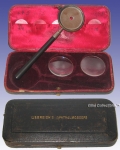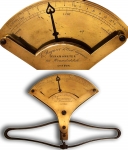Medical Antiques > Medical Diagnostic Instruments
Regnier Dynamometer to assess Human Muscle Performance
Item#: MED1128
SOLD
This 18th Century instrument is the first Dynamometer invented for measuring isometric muscle force. Made in London in 1798 and signed by the French Civil Engineer Edme Regnier (1751-1823) who worked in 106 Houndsditch street (near Liverpool street station). The instrument was used for assessing human muscle performance and determining clinical progression of neuromuscular weakness. With this Dynamometer two types of forces were measured: Pressure force by gripping and squeezing the double steel bow, and Traction force by pulling a single bow. Applying the force causes two dial hands to move up together, but one “freezes” at the maximum force achieved, while the other follows the grip or pull up or down to show the current force strength. Two scales are engraved on the brass dial plate: A). ‘Scale of Pressure’ divided into Stones and 'Hundredweight' (CWT), from 0 to 2 CWT or 16 Stones full scale (equal to 224 lb.). B). ‘Scale of Traction’ from 0 to 14 CWT or 112 Stones full scale (equal to 1568 lb.). Reference: Pearn J. (1978). Two early dynamometers. An historical account of the earliest measurements to study human muscular strength. J Neurol Sci. Jun; 37(1-2): 127-34
Related Items
-
 Price: $350.00
Price: $350.00 -
 Price: $75.00
Price: $75.00 -
 Price: $150.00
Price: $150.00
Development: Epoch | Design: Luch
Copyright © 1999-2024 Gilai Collectibles. All Rights Reserved





